DECEMBER.12.2016
THE GOOD SAMARITAN
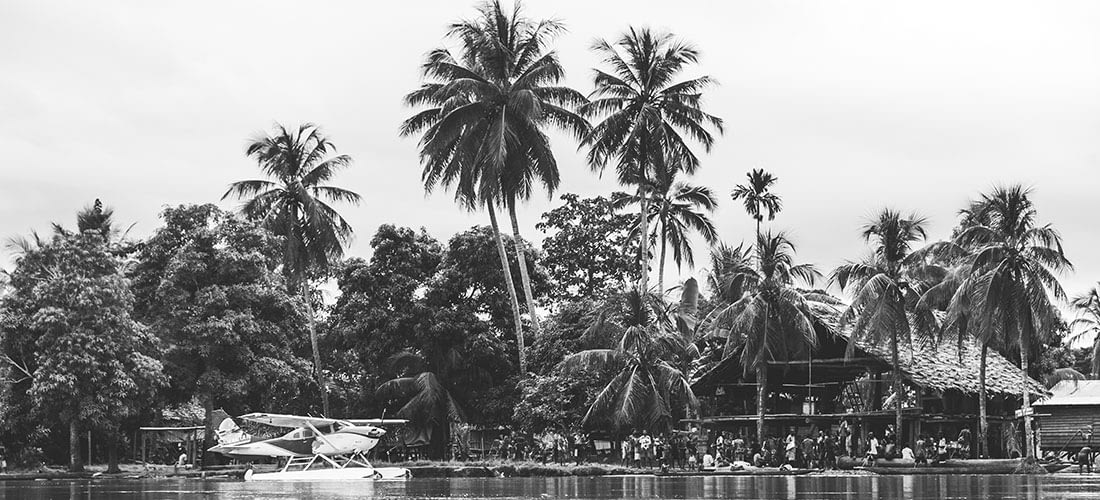
In Papua New Guinea, a country marked by dense jungles, perfect waves, and tribal violence, medevac pilot Mark Palm tries to balance lifesaving with a fanatical surfing life
From the sky above, the water of Papua New Guinea’s Chambri Lakes took on the dark translucence of black tea even as the winds of an approaching storm whipped its surface into a thousand wakes. This deceivingly rough water complicated the landing for pilot Mark Palm. A wheeled plane is governed “strictly by wind,” he said, but the pilot of a seaplane has to consider the velocity of river and ocean currents, the possibility of submerged objects, as well as changing surface conditions. Wind shear, water in the sky, water below—this particular flight already brought on the feeling of bobbing in a violent eddy. But now conditions on the “ground” proved problematic, too.
“I have to dip down and make sure it’s not too rough,” Palm said, banking the plane into a low loop over the lake. If a safe landing were not possible, we would be forced to return to the coast. And this would come as unwelcome news for the patient in the village who was, at that moment, in desperate need of medical airlift.
As Palm brought the floatplane level over the lake, I noticed 50 to 60 villagers gathered on the shore. Behind them, their thatch homes perched on stilts. Beyond the village, a green hill rose into a conical jungle peak. This feature dwarfed the settlement, making man’s mark on the landscape seem that much smaller. I couldn’t hear anything above the roar of the engine, but the waiting crowd exuded a stillness I took for silence.
“They don’t have a motor canoe,” said Chris Cooke, an American nurse who worked for missionary outfits. He was seated behind Palm and me, next to a gurney. He’d learned the trade language, Tok Pisin, and relied on it to perform tasks including the loading of patients, attempting to establish preliminary diagnoses and medical histories, as well as seeing to immediate care—all of this while navigating cultural cues that could potentially affect a patient’s outcome.
Palm pulled the Cessna 206 up into the sky again. It was clear in our exact location, but low tendrils of rain leaned toward us from the west. This front posed another challenge, as it put a distinct time limit on the landing and the retrieval of the patient. The fact that she would be paddled out to the airplane, in unstable conditions, pushed the time constraint to its limit. Palm decided to make the landing anyway. “We gotta get this lady on and get outta here, fast,” he said to Cooke. “This storm is going to be nasty.”
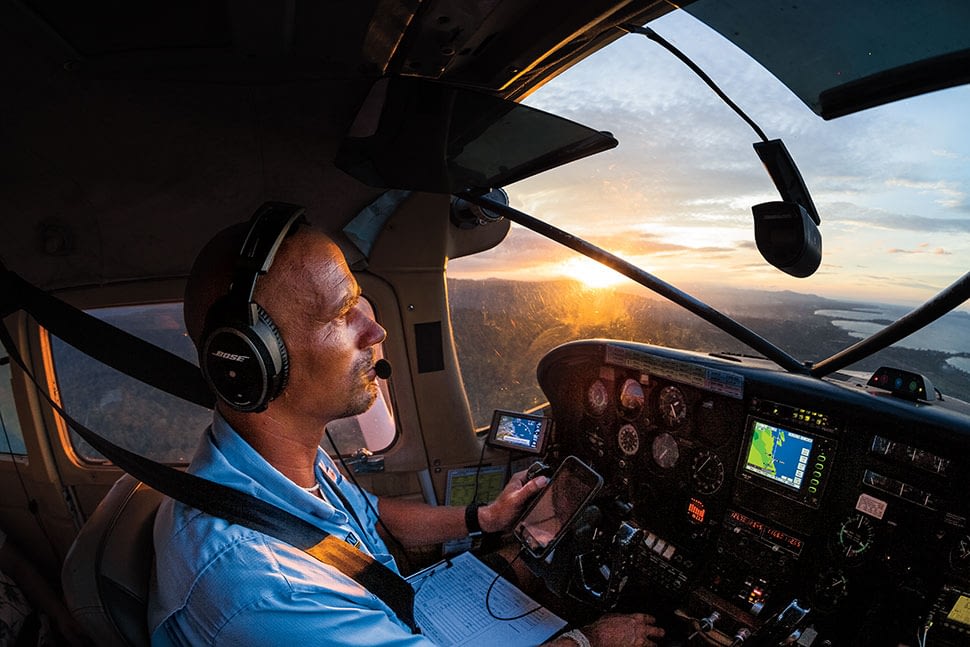
The Sepik River drainage, on the north coast of Papua New Guinea, comprises about 30,000 square miles. The river itself is a coiled, 700-mile-long serpent. During seasonal flooding, it consumes vast areas, linking lakes, oxbows and floodplains. Road building and maintenance can be a futile enterprise, as roads tend to disappear in a matter of months. There are no bridges. This leaves nearly 500,000 Papua New Guineans with few options for seeking emergency medical aid. In a dugout canoe, it may take three or four days to get to one of the two permanent roads that access the coast. There, a patient may have to wait a day or more for a vehicle to come along. All in all, a trip to the town of Wewak, the location of the region’s only hospital, may take a week. Complicated pregnancies are common in the area, as is domestic violence and tribal warfare.
In 2010, Samaritan Aviation, a nonprofit organization based out of Montrose, Colorado, brought the very first floatplane to a country dominated by water. And for the last six years this Cessna, piloted mostly by Palm, has served as the only efficient link between life-threatening events and medical treatment. Palm, a surfer from Santa Cruz, California, said he didn’t come here for the waves. That he discovered a variety of reefs and beaches was a lucky strike he attributes to God looking after him. Because the reason he says he came, to serve others, can get pretty grim.
In the sky, the aircraft felt light and pliable, but as soon as the pontoons touched upon the surface chops, it revealed itself as rigid and chattering. A pair of dugout canoes launched from the village. Each was about as wide as a man’s hips. I counted nine people in the slender dugout that carried the patient. Cooke stepped out of the cabin and onto a pontoon. “You go hurry up in here,” he shouted.
Palm then noticed that the wind had pushed the plane toward a mat of lake reeds. If stuck, extricating the pontoons from the reeds would cost time. He restarted the engine. The plane and dugouts parted like sticks on a river. A game of catch-up ensued. “We’re going to get rained on,” Palm said. The second attempt to dock with the dugouts went quickly, however. Cooke and the men loaded the woman into the cabin. We were also joined by a caretaker. This woman explained that Clara, the patient, had been in the aircraft before. The first instance was due to a complicated pregnancy. The baby had not survived, which made this run, another difficult pregnancy, all the more dire. Both lives were on the line. Palm turned the floatplane into the wind, and as the pontoons skipped from wake to wake, it slowly gained lift. The lake below receded and then joined a patchwork of swamps and oxbows that stretched away to the central mountains.
CIRCUMSTANCES HAD BLESSED PALM WITH AN UNUSUAL VARIETY OF GOOD WAVES IN WHICH TO QUENCH HIS SURF HABIT. BUT THE POVERTY AND VIOLENCE OF THE WILD INTERIOR ALSO SUPPLIED HIS FLEDGLING NONPROFIT WITH A STEADY STREAM OF TRAGEDY. THIS WAS NOT THE IDYLL OF THE TROPICAL SURF LIFE. BUT IT WAS MUCH MORE COMPELLING.
“That was an interesting one,” Cooke said.
Precipitation drained off of the windscreen, but the real rain was now in the rear view. Within minutes, as he pointed the nose of the Cessna toward the coast, Palm picked up a running conversation about surfboards, surfing technique, professional surfing, and famous waves around the world. I knew Palm was an avid surfer, but I would come to learn that he was also a fan in the original sense: a fanatic. Which made his life on the edge of this tropical island one of crosscurrents. Circumstances had blessed him with an unusual variety of good waves in which to quench his habit. But the poverty and violence of the wild interior also supplied his fledgling nonprofit with a steady stream of tragedy. This was not the idyll of the tropical surf life. But it was much more compelling.
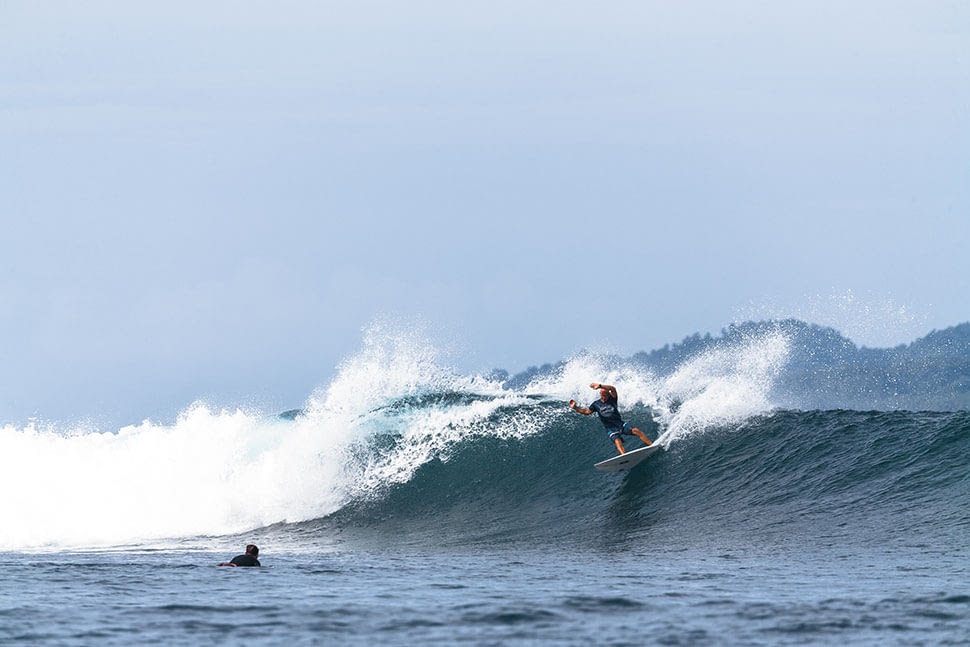
I met Mark Palm through a San Diego family who had been donating surfboards to a side project of Palm’s, which was getting Wewak-area kids into surfing. In this capacity, Palm had become something of a surfing Johnny Appleseed, coaching and helping to organize grassroots contests for local youths. My friend Shawn Butler was a shaper, and his son Jackson was a budding competitive surfer, so they had a slew of secondhand boards to donate. On this connection, I’d been invited to travel to PNG with the Butlers to check out Palm’s work and this new and interesting surf scene. In Wewak, Palm took us to a beachside village that had just caught the surf bug. The elders were so excited about the visit and group session, they offered to cook up a pig. This would take some time to organize, they said; a hole had to be dug, a pig procured. Could we come back in a couple of weeks?
Our surf routine became a way not of arriving, but of sliding into the country. Shortly after pulling up to another village, I was briefly confused by items dangling from the eaves of the thatch homes. A soapbox, a Pepsi can, shiny gold biscuit wrappers—all hung with fishing line—swirled in the breeze like mobiles or wind chimes. This was called bilas, I was told, and it fell into a category with jewelry and makeup—a way to spiff up a person or home. The bright and metallic colors of this curated, wellcared- for trash—a cigarette box, for example—contrasted the umber tones of thatch perfectly. I abandoned any effort to set these communities into a shared context with any others. As a group, I think, we visitors fell into a kind of Melanesian slumber, one of suspended disbelief.
We motored out to a tiny island where a half-moon reef caused waves to pinwheel around the shore. On the coral beach, a giant rain tree had been knocked over; its exposed roots reached up into the shape of a longship’s bow. Island kids climbed aboard the tree and ascended its roots as if they were stadium seating. They cheered when the first surfer took off, and they continued to cheer each ride — louder when someone fell, and loudest when one of us became splayed on the bone-dry reef.
One day I got a chance to surf alone with Palm at his regular spot, a reef that reminded me of similar breaks on Oahu’s south shore. Palm’s personal style suggests something vaguely military. He’s fit and has a shaved head and a habit of long and direct eye contact. He says things like, “Keep your head on a swivel.” This manner fits his work, but seems in contrast to his story: one of a big dreamer, a scrappy hustler, a guy prone to fixation (during our session, he got out of the water to watch a WSL heat on his smartphone, then paddled back out and picked up the conversation—something no surf partner of mine has ever done).
Palm first came to Wewak in 1994 with his friend Gary Bustin, a future co-founder and president of Samaritan Aviation. Bustin hailed from a longstanding missionary family, had been born in PNG, and lived there until he was 12. That ’94 trip was a kind of return for him, but he said it was also an “exploratory adventure” for both. Their Christian backgrounds had instilled in them a desire to serve others in some way. Being young, their first plan was an ambitious one. A Christian evangelist group called the Power Team was popular at the time; its members performed feats of strength
PALM DESCRIBED THE DECADEPLUS ODYSSEY OF GETTING SAMARITAN AVIATION OFF OF THE GROUND, THE YEARS OF GAINING EXPERIENCE AND PATCHING TOGETHER ODD JOBS WHILE BUILDING THE INFRASTRUCTURE OF THE NONPROFIT. BY THE TIME PALM FINALLY ARRIVED IN PNG WITH A FLOATPLANE, HE WAS MARRIED WITH THREE CHILDREN IN TOW. HE HADN’T REALLY SURFED IN EIGHT YEARS. AND NOW, SUDDENLY, HERE WERE ALL OF THESE WAVES AND NOT A SURFER IN SIGHT.
allegedly made possible by faith—tearing phone books and breaking wooden boards. Having trained in martial arts, Palm and Bustin planned to inspire religious conversions with feats of their own. But their theatrics didn’t seem to stick in the more developed areas they visited. So the pair sought out remote locales and impressionable audiences. This, and surfing, led them to an island in the north of PNG, where they encountered a boy suffering with a festering machete wound. Having completed EMT training, Bustin carried medical supplies. Helping the boy felt good, and much more productive than karate tricks. Then and there the idea of service through medical aid took hold of the Americans. It was not hard to see that a country with lots of water and few roads or airstrips might benefit from a floatplane. After returning to the United States, Bustin and Palm enrolled in flight training.
In the water off Wewak’s military base, Palm described the decade-plus odyssey of getting Samaritan Aviation off of the ground, the years of gaining experience and patching together odd jobs while building the infrastructure of the nonprofit. For management purposes, Bustin remained in the U.S. By the time Palm finally arrived in PNG with a floatplane, he was married with three children in tow. He hadn’t really surfed in eight years. And now, suddenly, here were all of these waves and not a surfer in sight.
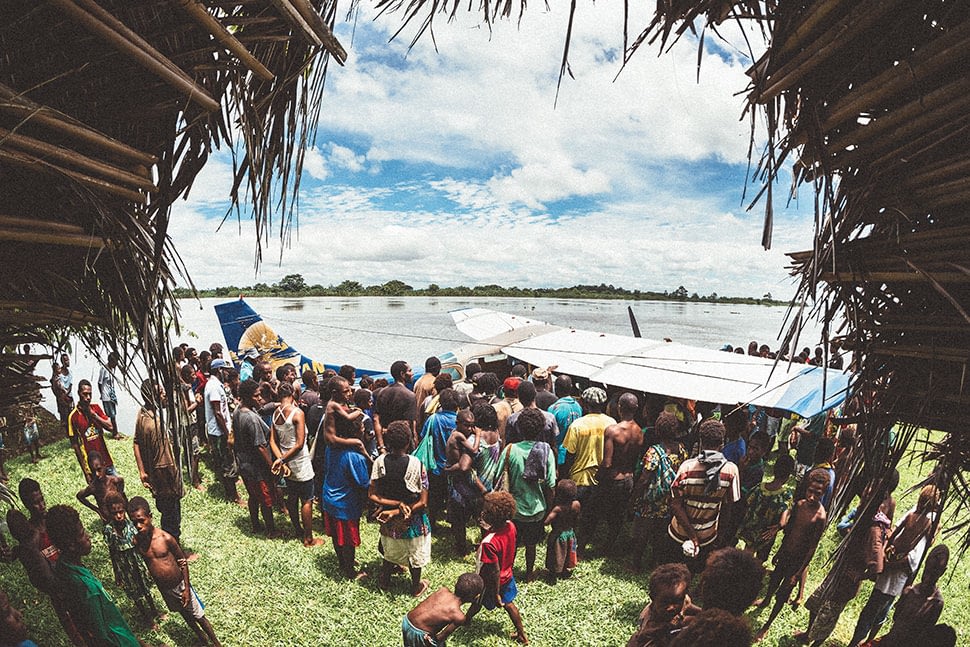
While Palm attended to the Cessna, I rode with Cooke in the organization’s ambulance—a Toyota Hilux. Clara laid in back on a gurney. If it weren’t surrounded by jungle, Wewak would not pass for a town. It was a mere strip of structures and clearings along the looping coast. We passed the runway where jets land. Bomb craters can still be seen along its length, the result of the Allies’ attack on Japanese warplanes in WWII. These craters fill with water and are said to be frequented by crocodiles. The Wewak hospital is a cluster of low buildings that occupy an egg-shaped peninsula. A long left wraps teasingly along one side. The hospital road circled around to the emergency entrance, which turned out to be an uneven wooden ramp. The wheelchair that carried Clara inside consisted of a school kid’s desk chair mounted to a trolley with four wheels. A surgical table leaned against a palm tree in a side yard, rusting away. According to Cooke, the hospital often ran short of standard supplies. Surgeries were sometimes conducted without anesthesia. I later had a chance to visit the hospital kitchen, where three cooks chewed betel nut and lime (a national pastime that causes mouths to appear bloody red) while they boiled up a starchy mush called saksak for the patients.
This hospital served a population of a half million.
As a nation, Papua New Guinea is only 40 years old. A Westerner born there, the son of two generations of missionaries, described it as having one foot in prehistory, the other in the age of the jet. He claimed to know New Guineans who were raised wearing loincloths, but ended up graduating from Harvard University. Cultural holdovers from the old tribal world popped up occasionally. One was extrajudicial killings as punishment for sorcery. When invisible pathogens struck members of a village, for example, the illnesses were sometimes chalked up to black magic, in which case the blame could be hung on a person. According to Palm, a young girl had recently been killed in the area following an otherwise explainable bout of disease.
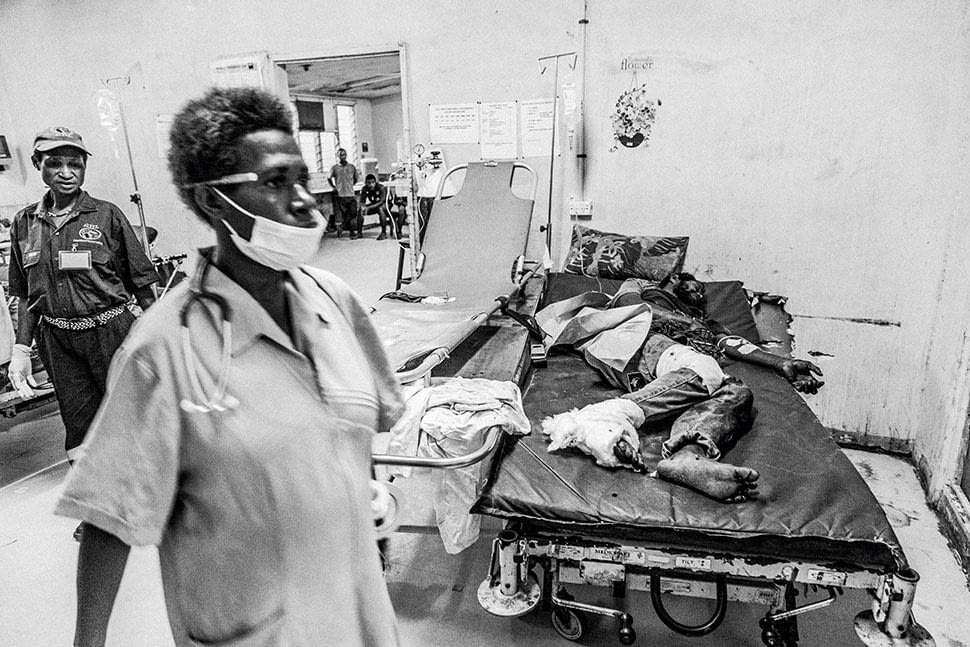
At the outset, I thought the Samaritan Aviation missions would have been straightforward: fly in, land, pick up patients, fly back. Cooke described a scene in which he flew to a remote lake with Samaritan Aviation pilot John Smith. They had been called to retrieve a small girl who had fallen sick. Dominion over the lake was split between two villages that sat on either side, and their populations were in conflict. Smith made the mistake of landing near the wrong shore. As Cooke explained, “The bush knives came out immediately.” Armed with machetes, the villagers were not going to allow anyone from the opposing settlement aboard the aircraft—despite the fact that the patient was a child. That Samaritan Aviation arrives only for those at risk of dying was something all sides would have known. Though angry and aggressive, the machete wielders had to know that Samaritan Aviation would have come for their children as well. Eventually, Smith was able to talk the men into lowering the weapons—just long enough to get the kid into the cabin.
Cooke said he worried that this equal treatment of patients had developed a downside. Both he and local nurse Louisa Raeleo described instances when Samaritan Aviation landed to retrieve victims of tribal warfare. Once the injured were aboard, their kinsmen would say something along the lines of “See you tomorrow.” This puzzled Cooke until he heard the second part of the sentiment: “Because we’re going after the people who did this, and they’re going to need emergency evacuation too.”
“They want to take revenge on the other side,” Raeleo said. “They cut them up.”
Cooke wondered if, by offering the option of hospital treatment, the ambulance service might be promoting violence in instances that, without access to medical care, may have ended in a negotiated settlement. The answer, however, could not be known. The distance of the villages prevented authorities from prosecuting known crimes. Without the link that Samaritan flights created, there is a chance that news of violence would not even reach the outside world.
The remoteness of the villages created additional challenges. Raeleo described a situation in which she was presented with two patients, both the victims of spear attack. One of them still had the spear stuck in him. But Raeleo could admit only one man aboard the aircraft at that time. The lacerations on the victim without the spear, the nurse noticed, were quite small but bleeding fast. “He would have bled to death,” she said. So Raeleo took the man with tiny cuts, leaving the man pierced with the spear to wait for the next flight.
COOKE WONDERED IF, BY OFFERING THE OPTION OF HOSPITAL TREATMENT, THE AMBULANCE SERVICE MIGHT BE PROMOTING VIOLENCE IN INSTANCES THAT, WITHOUT ACCESS TO MEDICAL CARE, MAY HAVE ENDED IN A NEGOTIATED SETTLEMENT. BUT WITHOUT THE LINK THAT SAMARITAN FLIGHTS CREATED, THERE IS A CHANCE THAT NEWS OF VIOLENCE WOULD NOT EVEN REACH THE OUTSIDE WORLD.
Several months before I arrived, a woman in the interior gave birth to healthy twins. But, for some time afterward, the mother appeared to be struggling for her life. Samaritan Aviation was called for a pickup. It turned out that a third child was trapped in the womb. After the emergency flight, a Csection was performed at the Wewak hospital and a healthy infant girl was soon drawing air into her lungs. The mother pulled through as well, leaving both the Samaritan and hospital staffs thrilled. It came as a shock when the mother died unexpectedly the next day. Even more shocking, was that when the mother’s family came to retrieve her body for burial, they made no plans for the baby girl, stranding the infant in the hospital.
Cooke told this story while we sat in the ambulance waiting for Clara’s hospital admittance to be completed. I’d been staying in Samaritan Aviation’s fenced compound, where the staff and their families lived. Cooke’s story recalled a detail I’d noticed about his children when they played outside their flat. A member of the family was always carrying a New Guinea toddler whom I knew as Baby Charlotte. This was the child left at the hospital. The Cookes were in the process of adopting her. It struck me that although the Samaritan Aviation flights required timely and focused commitment, those brief airplane rides had the ability to forge lifetime commitments as well.
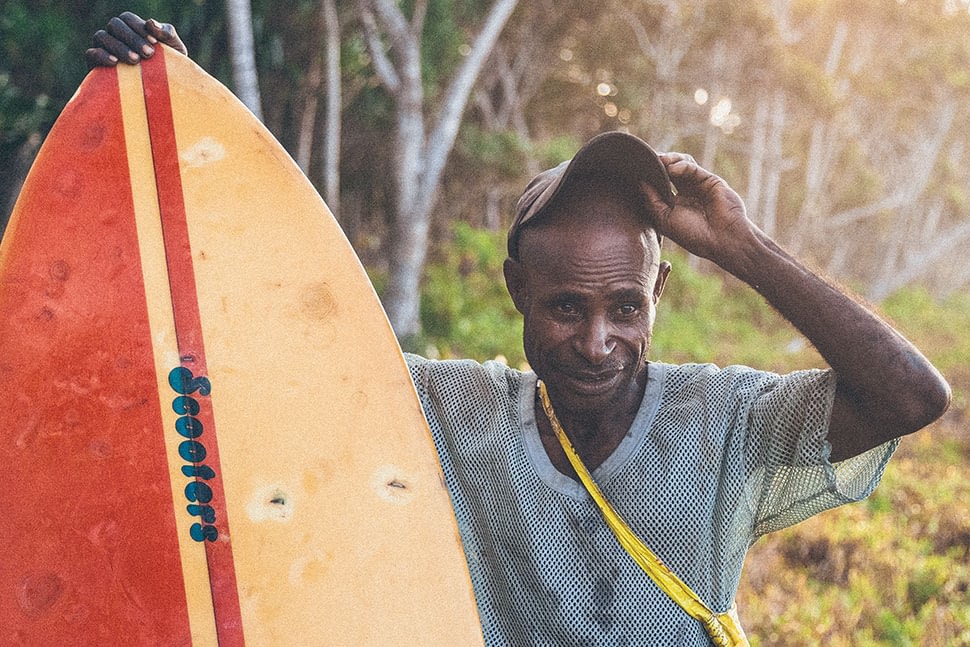
The nature of picking up a patient in trouble and delivering them to the hospital always left the outcome as a bit of a cliffhanger. During my visit, Samaritan received a call about a man who was dai (dead), as opposed to dai pinis (“dead finished,” or completely dead). This confused the Samaritan staff until Palm and Cooke reached the interior and encountered a patient who was unconscious and presenting vital signs so slight, he appeared dead. At some point in mid-air, this man, who had likely seen very few airplanes in his life, much less flown in one, woke up. The shock of being trapped above the Earth with two white men caused him to go berserk, and he leapt from the gurney and tried to escape the plane. “This was a lean, mean fighting machine,” Cooke said. It took everything the nurse had to calm the man. For the rest of the ride and at the hospital, the patient seemed healthy, so he was quickly released. A week later, Samaritan received the same call: The description was dai, but not quite dai pinis. This time the man awoke in the hospital and, again, seemed totally healthy.
That week, Samaritan airlifted an infant who was born with its intestines outside of its body. There was another machete victim whose scalp had been split down the middle. On a run-of-the-mill medicine delivery, Palm was presented with a pregnant woman who had been attacked and kicked in the belly by her husband.
In small acts of genuine concern, the Samaritan staff—the Cookes and Palm’s wife, Kirsten—returned to the hospital to look after their former passengers. In this way I was able to get some of the backstory to the patients I’d seen and whose plights I had followed during my stay. The hospital did blood work on the man who was dai. It turned out he was a diabetic, and entering diabetic coma. The infant with the exposed intestines died within a day. The machete victim was rushed into surgery. Clara, the patient picked up from Chambri Lakes on my first ride-along, delivered a healthy baby and was doing well herself.
The Palms escorted us to the airport on the final day of our trip. As is typical of South Pacific depots, we had time to wait. Our time in PNG had been action-packed, and subtle questions of Palm’s motivation were left lingering in my mind. With Kirsten at his side, I told Palm that I thought he was a surfing fanatic.
I had been thinking about one golden evening when I waited at the Samaritan hangar with a friend of Palm’s named Chris Tang. Soon we heard the buzz of the floatplane and saw its white-and-blue speck returning from the interior. On landing, Palm wheeled the Cessna right up to the hangar. Stepping down onto the pontoon, he waved us over to help lift the patient and gurney out of the cabin. This was Easter weekend and village celebrations had degraded into violence. The patient had been speared in the belly and hacked up with a machete. There were open wounds on his head. One knee was slashed through to the tendons. I happened to grab the foot end of the gurney and looked down to see that the man’s toes had been sheared almost completely off; they hung to the side by strips of skin. We loaded the patient into the ambulance and Cooke sped away. Palm stepped up to the cockpit to grab his things. He turned to Tang and me and said, “Hey, did you guys see that Adriano de Souza lost his heat?”
Tang and I looked at each other. Then we looked at Palm. Neither of us had to mention the discordant image of Palm staring at his phone, watching surfing, while a bloodied man clung to life in the back of the cabin. “You watched a surf contest in flight?” I asked.
“I was about 10 minutes out. There was nothing to do but fly the plane,” he offered.
Palm could see the disbelief on our faces.
“Come on,” Palm scoffed. “I said a prayer for the guy.”
When I confronted Palm with this question of surf obsession at the airport, he began to defend himself, but Kirsten broke in and said, “Don’t let him deny it.”
Contrary to what many surf-themed nonprofits might have us think, I never thought surfing and public service ever fit together very well. They’re not quite opposites, but they are incongruent. You can’t surf your way to a better world. But for people whose lives are consumed with serving others, there is a matter of emotional equilibrium.
“You see so much trauma,” Palm said. “I have to guard against it. Surfing helps me find balance.”


